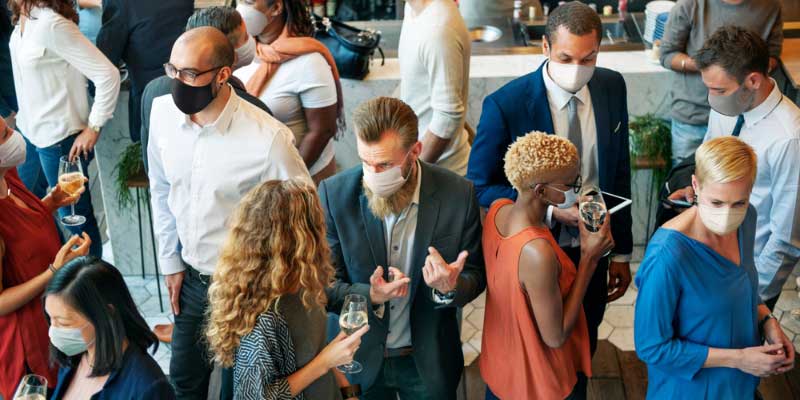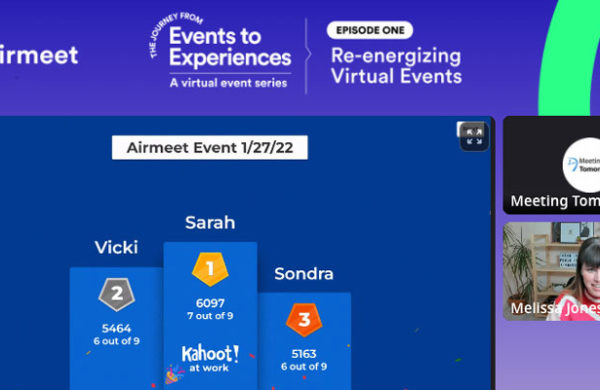
As event planners know, hosting an in-person event during the COVID-19 pandemic requires serious consideration and development of a detailed safety plan. This work requires collaboration with local public health officials, careful assessment of risks, and a detailed plan on how to mitigate them.
If you’ve decided to plan an in-person event, and you’ve developed a plan you feel confident in, a key part of executing it is communicating clearly with your attendees. Whether through your website, emails, social media, on your event app, or onsite, it’s critical to communicate early and often, and with as much transparency as possible.
Our checklist below outlines key elements to communicate to your attendees. When describing your protocols, it’s reassuring to let attendees in on your process. Explain the factors you considered when making your plan, and who you collaborated with in developing it.
Pre-Registration
Be as transparent and thorough as possible about your safety plan before attendees register. This helps attendees make the right choice for them, and avoids confusion later on.
Venue and Basic Event Details: Beyond the basics, describe any safety features your venue includes. For example, highlight any outdoor spaces you’re planning to utilize, ample space for social distancing, ventilation features, etc.
All Attendee Entrance Requirements: Be as specific as possible about what exactly is required for your attendees to enter and participate in your event. Don’t assume that everyone understands local regulations, since they vary by state and city. Also, if your event requirements differ from the venue requirements, make sure to specify why and how.
Describe in detail your:
- Mask Requirements
- Vaccine Requirements
- Negative Test Requirements
- Self-certification requirements (If an attendee needs to self-certify they do not have any symptoms, or have not been in direct contact with a person who has a confirmed or suspected case of COVID-19.)
- Onsite temperature scans
You should also communicate any consequences for if an attendee does not adhere to your requirements.
Staff Requirements: List staff safety protocols (including any vaccination and/or mask requirements) and how you’ve trained your team.
Expected Attendee Count: Describe your expected attendee count, and how you plan to enforce it.
Social Distancing Expectations: Will seating be distanced? Are attendees expected to keep distance from one another? Will there be a way for attendees to describe their comfort level (wrist bands, lanyards, etc?) Describe your distancing expectations.
Safety Supplies: What supplies (i.e. sanitizing stations) will be provided for each attendee and in the event space overall?
Refund Policy: Consider a flexible refund policy (which can encourage people to stay home if they feel sick), and communicate it clearly.
Virtual Participation: Are you offering a virtual option for attendees to participate? Will sessions be recorded, so attendees who are unable to make it can watch afterwards?
Emergency Plans: How do you plan to communicate with attendees in case of an emergency? What will happen if your event is cancelled? What will happen if an attendee onsite is confirmed to have COVID-19? Highlight your emergency plans.
Who should attendees contact if they have questions? It’s important to be as responsive as possible to attendees’ questions about safety. Be sure to add contact information where people can get in touch before, during, and after the event.
Post-Registration
Your Check-in Process: Describe what attendees can expect onsite.
Your Safety Lead: Send a communication pre-event that features your safety lead who will be handling any issues onsite. It’s comforting to attendees to know that there is a dedicated resource managing any safety concerns that may arise.
Agenda: In addition to all your agenda basics, describe how the agenda has been updated to allow for a flow or rotation that is beneficial to attendees.
During Event
Signage and Announcements: Emphasize your safety protocols through signage in key areas like gathering areas, bathrooms, and eating areas. List where attendees should go with safety concerns. Make sure your signage is accessible in all languages spoken at your event.
Event Reminders and Announcements: Reinforce key safety protocols throughout your event.
Post-Event
Signage and Announcements: Survey your attendees and staff to share additional feedback to help improve safety plans and communication for future events.
Are you planning an event? We’d love to learn about it! Reach out to us here to learn how we can produce your hybrid, virtual, or fully in-person event in any city nationwide.



